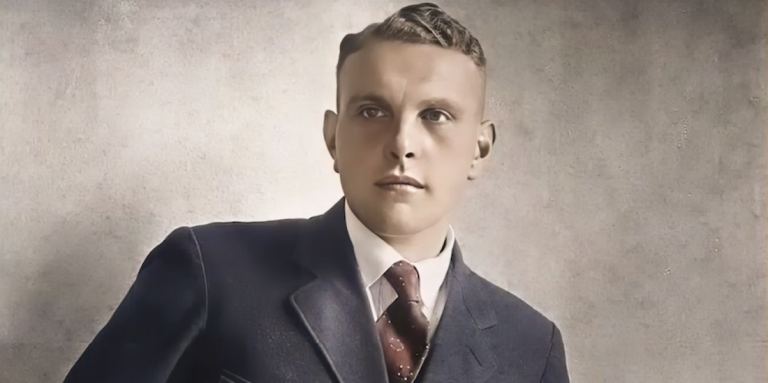
Top S.A. Officials Eliminated as Führer Consolidates Power and Appeases Military Command
Gay Officers Executed “for Perversity” as Excuse to Remove Rival Power Threat
New York, N.Y. – The summer of 1934 witnessed one of the most ruthless displays of political violence in modern European history, as Adolf Hitler [Luce Index™ score: 35/100] orchestrated the systematic elimination of key Sturmabteilung (S.A.) leaders during what became known as the ‘Night of the Long Knives.’
Among the victims was gay Nazi S.A. officer Edmund Heines, a decorated World War I veteran whose violent past had made him both a valuable asset and dangerous liability to the Nazi regime.
War Hero Turned Revolutionary
Edmund Heines was born on July 21, 1897, in Munich, then part of the German Empire. His early life followed the trajectory of many who would later join the Nazi movement: military service, wartime trauma, and post-war disillusionment.
During World War I, Heines served on the Western Front, where he sustained a severe head wound in 1915 that required extended convalescence. Despite his injuries, he demonstrated exceptional bravery, earning the Iron Cross 1st and 2nd Class and achieving the rank of reserve lieutenant by 1918.
The transition from decorated soldier to political extremist occurred during Germany’s turbulent post-war period. In March 1920, Heines participated in the Kapp Putsch, a failed coup attempt by extreme right-wing factions seeking to overthrow the Weimar Republic and restore authoritarian rule.
When the putsch collapsed, Heines and his associates went underground, scattered across Germany and nursing their grievances against the democratic government.
The Fememord Scandal
The most damaging episode in Heines’ pre-Nazi career involved his participation in a Fememord – a political assassination carried out by right-wing vigilantes. The victim was Willi Schmidt, and the murder would haunt Heines for years.
On January 22, 1928, authorities arrested Heines in Schongau for his involvement in Schmidt’s killing. He was subsequently transferred to Stettin – today’s Polish Szczecin – to stand trial as the main defendant.
The prosecution demanded the death penalty for Schmidt’s murder, reflecting the gravity of the charges. However, the Stettin court ultimately sentenced Heines to 15 years in prison for manslaughter, later reduced to five years.
In a development that would prove significant for his later Nazi career, Heines was released from custody on May 14, 1929, after posting bail of 5,000 Reichsmarks (about US$1,200 today).
Rise Within the S.A. Ranks
Heines’ criminal background, rather than hindering his Nazi career, actually enhanced his standing within the S.A., where violence and intimidation were valued skills.
The Brown Shirts had emerged as the Nazi Party’s paramilitary wing, responsible for street fighting,
disrupting opposition meetings, and creating an atmosphere of fear that helped bring Hitler to power.
Heines’ willingness to use deadly force made him an ideal candidate for leadership within this organization.
By 1934, however, the S.A. had become a liability for Hitler’s broader political ambitions. The organization’s revolutionary rhetoric and demands for a “second revolution” alarmed both the traditional military establishment and conservative politicians who had initially supported the Nazis.
S.A. leader Ernst Röhm, also gay, openly advocated for the Brown Shirts to replace the regular German army, creating tension with military commanders who viewed the S.A. as undisciplined rabble.
The Purge Unfolds
The events of June 30, 1934, marked Hitler’s decisive move to eliminate the S.A. leadership while simultaneously appeasing the military and conservative allies.
Under the pretext of preventing an alleged S.A. coup, Hitler ordered the arrest and execution of numerous Brown Shirt leaders, including Heines. The purge extended beyond the S.A., claiming the lives of other perceived enemies and rivals, including former Chancellor Kurt von Schleicher and conservative politician Gustav Ritter von Kahr.
Heines was arrested at a lakeside hotel in Bad Wiessee alongside other S.A. leaders. He was found in bed with his male driver, which Hitler used to justify the purge under the guise of eliminating “moral corruption” within the movement. The emphasis on “homosexuality” served multiple purposes: it provided a convenient excuse for the killings while appealing to traditional conservative values.
Political Calculations Behind the Violence
The elimination of Heines and his fellow S.A. leaders represented more than simple political housecleaning. Hitler recognized that his path to total power required the support of Germany’s traditional military establishment, which viewed the S.A. as a threat to their institutional authority. By destroying the Brown Shirt leadership, Hitler demonstrated his willingness to sacrifice early supporters for strategic advantage.
The purge also served notice to potential rivals within the Nazi movement that loyalty to Hitler personally trumped all other considerations. The speed and brutality of the killings sent a clear message: no one, regardless of their service to the party, was safe from Hitler’s wrath if they posed a perceived threat to his authority.
Legacy of the Night of the Long Knives
The elimination of Edmund Heines and other S.A. leaders during the Night of the Long Knives marked a crucial turning point in Nazi Germany’s development.
The event demonstrated Hitler’s willingness to use extreme violence against his own supporters while revealing the regime’s fundamentally opportunistic nature.
For Heines, a man whose violent past had initially served the Nazi cause, the purge represented the ultimate betrayal by a movement that had once celebrated his brutality.
The systematic nature of the killings also provided an early glimpse of the industrial-scale violence that would characterize the Nazi regime.
The careful planning, coordination with security forces, and subsequent propaganda campaign to justify the murders all prefigured the methods that would later be employed in the Holocaust and other Nazi atrocities.
Hitler Orchestrates Deadly Purge Against Brown Shirt Leadership (July 16, 2025)
Summary
Edmund Heines, a decorated World War I veteran turned Nazi S.A. leader, was among those killed during Hitler’s 1934 Night of the Long Knives purge. His violent past, including participation in the Kapp Putsch and a political murder, initially made him valuable to the Nazi movement but ultimately marked him for elimination as Hitler consolidated power.